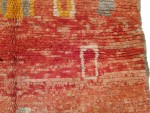Rug with Neolithic Motifs
In the 16th century the plains located north of Marrakech were the site of a huge lake rich in fish, and the nearby Rehamna massif was dense with trees and called the Green Mountain. The Rehamna area attracted groups of both Arab (El Araba) and Saharan (El Rherraba) origins. The rugs of the Rehamna tribes can be generally divided in two types: qtifa, which have monochromatic red fields, and zarbiya, in which the design is sometimes endowed by an abstract, ancient language. Rehamna weavers appear to employ a system of ideograms which finds its roots in Neolithic cave paintings. The result is what Paul Vandenbroek defined as the ‘spontaneous style’ (Vandenbroek 2000), which consists of a variety of forms that appear and then dissipate almost like an electric discharge, deriving from the unconscious of the female weavers and intimately connected to their Neolithic past. The fact that such archaic motifs appear on a 20th century rug is accounted for by the very close connection between the art of weaving and the Neolithic, as well as the speed of evolution among certain civilisations.











